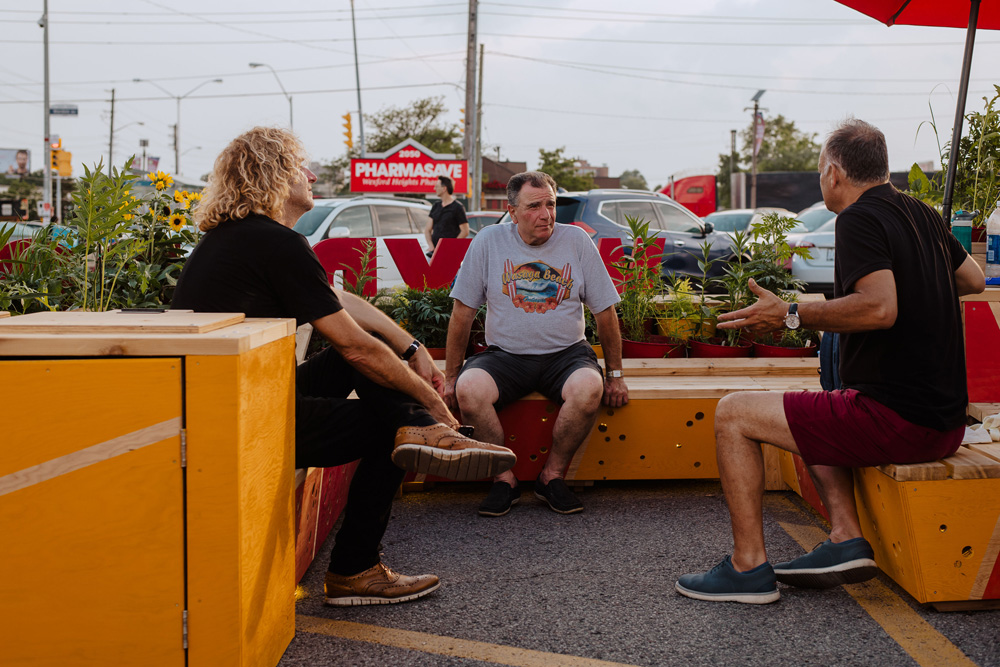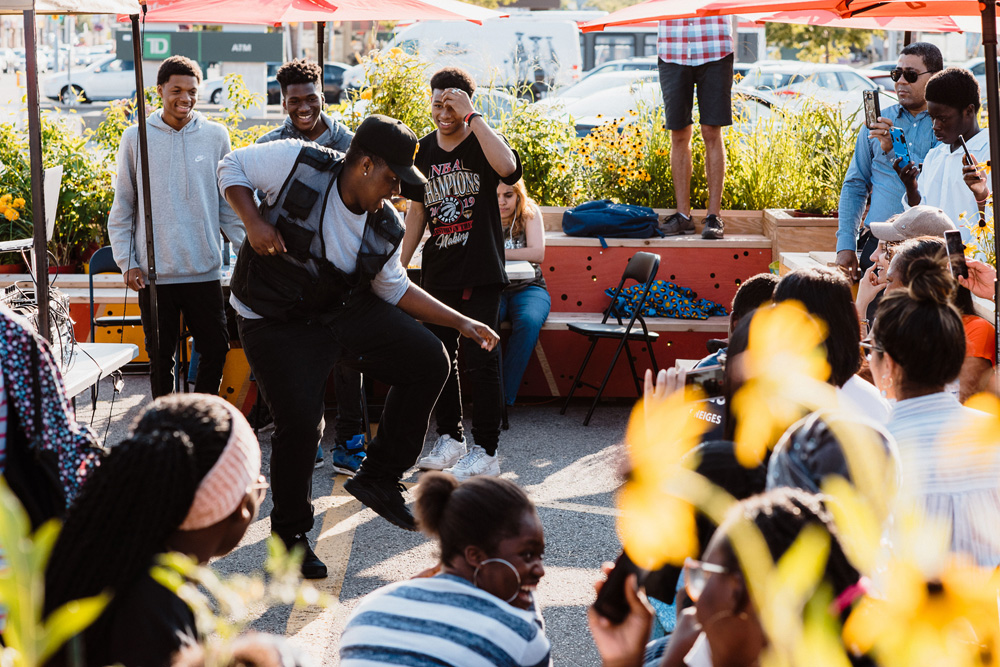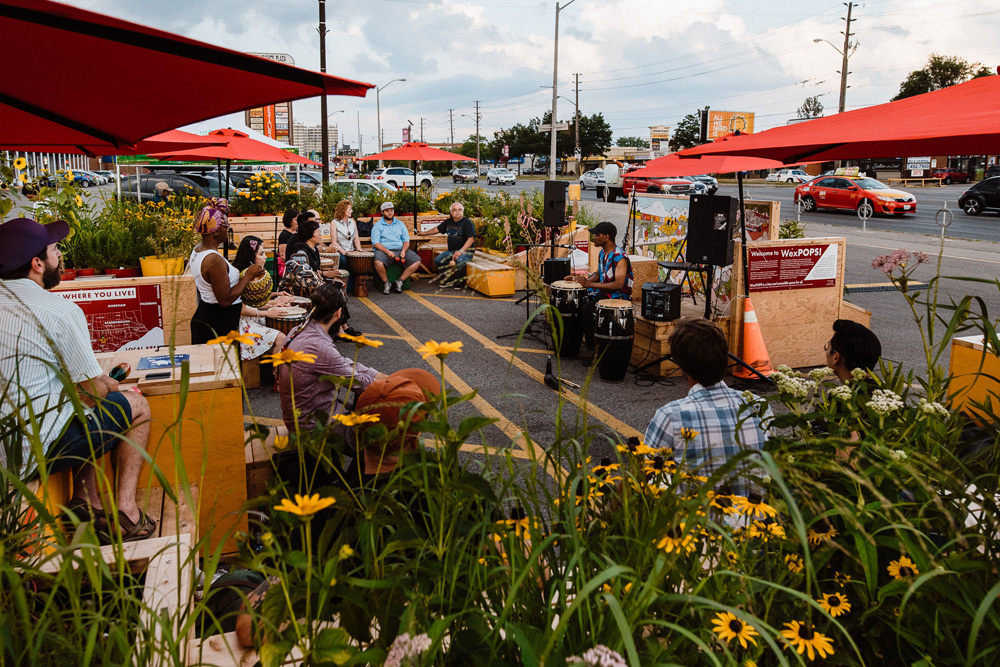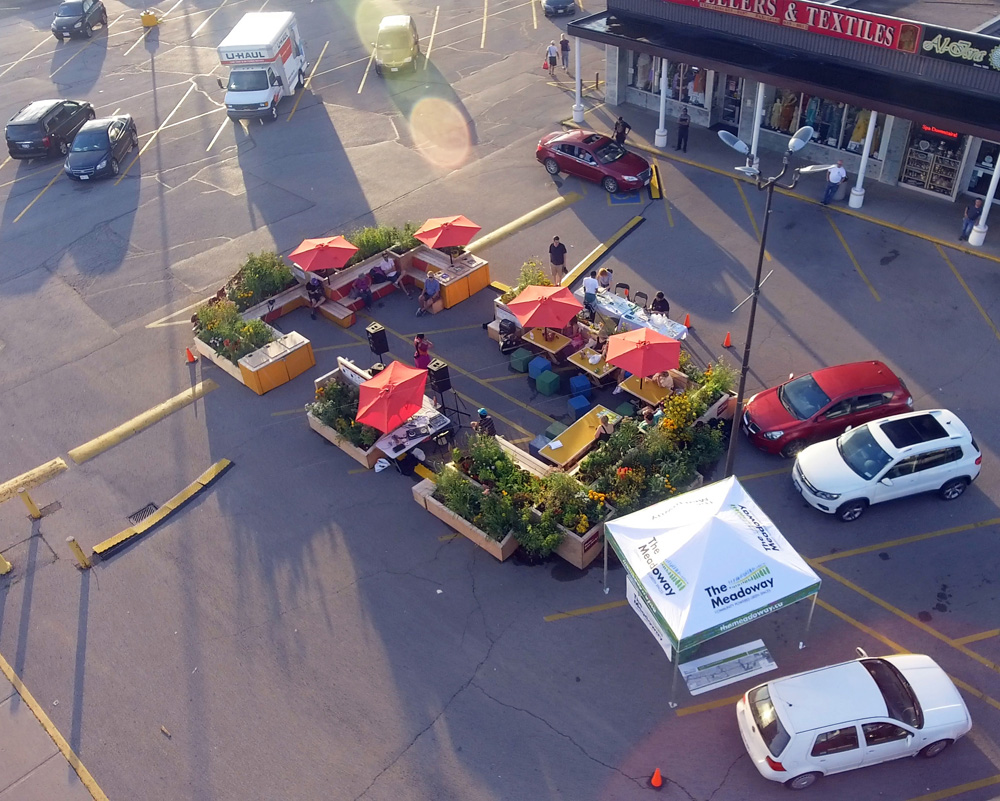plazaPOPS: Accessing the urban suburban
Text by Brendan Stewart, OALA, Daniel Rotsztain, and Karen Landman
plazaPOPS is a design research initiative that started as an MLA thesis project, and developed into a grant-funded pilot called WexPOPS, installed for six weeks during the summer of 2019. Situated in the parking lots of vibrant commercial strip-malls in Toronto’s inner suburbs, the big idea is to develop a new type of community gathering space that creates multiple benefits for the local community, and the business and property-owners who host the installation. plazaPOPS explores concepts of access by inviting more complex uses into typically less-accessible, privately-owned space, and within the installation itself, setting the stage for greater access to ourselves and to each other.

A new type of POPS
Most POPS (privately-owned public spaces) are permanent, built by developers on private property and negotiated as a public benefit through the planning approvals process—think of a publicly accessible parkette at a street corner on the site of a new condominium building. plazaPOPS are also on private property, but they are community initiated and temporary, popping up during the warmer months. They are imagined as a short- to medium-term strategy, enhancing the public realm today with the goal of informing the longer-term evolution of the neighbourhood, as densification continues.
plazaPOPS invites the public to spend time in a parking lot the way they might in a traditional public space: to linger and people watch, to smell the flowers and admire a butterfly, to meet a friend for a coffee or take in a programmed event, or to rest comfortably for a few minutes, while waiting for the bus. Uniquely, all of this takes place under the dynamic lights of strip-mall signage, surrounded by parked cars, in a neighbourhood filled with a truly international assortment of restaurants and shops. There is no cost to enter and everyone is welcome.

For the concept to work, people need to perceive the space as welcoming and open to them. A major lesson learned from our 2019 pilot was that some initially assumed that the space was a place of commerce, perhaps a new patio space for an adjacent restaurant, or—and we took this as a compliment—a nursery business selling plants! Curiosity and time cleared this up for most people who regularly travelled by the space, but future iterations should include larger and simpler signage, scaled to be legible from fast moving cars and busses, and clarifying the free and welcoming nature of the space. We learned that, to compete for attention in the land of big and vibrant signs, it’s best to do as the locals do.

Equally important, the landowner and business community needs to see the project as a sound business strategy, and worth the loss of valuable parking—ten stalls, in the case of WexPOPS. Our partners at the Wexford Heights Business Improvement Area saw potential in the project as a new type of BIA strategy, tailored to the conditions of sprawling suburban main streets—something beyond conventional hanging basket programs, and different from complex and expensive street festivals, and recognizing that most of the public realm in these parts is privately owned. They saw a creative model that would give back to the community, while creating business opportunities. The many local restaurants, for instance, might benefit from new customers visiting the strip, drawn in by WexPOPS.

Currently, not all strip-mall parking lots have parking spaces to spare; in these instances, land and business owners understandably see plazaPOPS as a non-starter. Our analysis suggests, though, that many lots have under-utilized and leftover space that can be reclaimed and occupied, or, as in the case of our pilot site, an over-supply of stalls.
Ultimately, we entered into a land access and license agreement with the landowner and secured all of the necessary permissions and insurances to cover liabilities, but the important part was the process of building reciprocal, trust-based relationships, developed through an 18-month, community-driven planning and design process. Community projects require an immense amount of time, and even more, it turns out, especially when you have to negotiate expanded access to private property. WexPOPS relied on the local networks and capacity of the BIA. Partnerships with local organizations will be essential to facilitate the design process and manage the site in future iterations.
Finding an open-minded and community-oriented landowner for our pilot was pivotal, as was partnering with an imaginative BIA with capacity. Local politicians, City of Toronto staff in the BIA office, and Transportation Services championed and supported the project in many ways, legitimizing our efforts and making it easier for project partners to say ‘yes.’

A place for the community to meet itself
In the 1960s, the French Marxist philosopher and urban theorist Henri Lefebvre began writing about ‘le droit à la ville’ or ‘the right to the city’—an idea formed in response to his perceptions of the environmental and social destructiveness of capitalist urbanization processes.
Lefebvre was concerned that the prioritization of landowner rights (its ‘exchange value’) over the role that land plays in meeting the needs of inhabitants (its ‘use value’) would lead to the erosion of ‘the urban.’ Arguing the contemporary relevance of these ideas, democracy scholar Mark Purcell defines Levebvre’s vision of ‘the urban’ as spaces that connect inhabitants in a meaningful way, and engage them in “the meaning and future of the city.”
Pared down, the idea of ‘the right to the city’ might be described as a right for individuals and communities to access the psychological, social, and economic benefits associated with ‘the urban’: to develop and benefit from what contemporary sociologists would call ‘social capital,’ and the right to be engaged in the making and evolution of their environment.
There is little doubt that higher population densities create more potential for the urban condition to emerge, but, defined in this broader sense, one can rightly critique some high-density development as anti or weakly urban, and looking elsewhere, can observe a robust urbanity in the suburbs.
plazaPOPS is inspired by the rich vitality of community life that exists inside the walls of the inner suburban strip-mall, and motivated to allow this existing urbanity a chance to spread beyond the buildings and business hours. To give the various communities in the neighbourhood a chance to meet and get to know each other under the sky. In this way, plazaPOPS tries to enhance the ‘urban’ already in the suburban.
WexPOPS was hosted by the Kiriakou family, owners of the Wexford Restaurant and was funded by Ken and Eti Greenberg and the Balsam Foundation through Park People’s Public Space Incubator grant, as well as the City of Toronto’s BIA Kickstarter Fund and support from the University of Guelph’s School of Environmental Design and Rural Development. The team is writing up the findings of the data collected during our 2019 pilot, and focussing on a policy analysis and regional mapping project to identify candidate sites for future plazaPOPS. You can reach the team at [email protected].
BIOs/ Brendan Stewart, OALA, is an Assistant Professor in Landscape Architecture at the University of Guelph’s School of Environmental Design & Rural Development. His research and creative practice focuses on the role of design in the evolution of cultural landscapes.
Daniel Rotsztain is the Urban Geographer, an artist, writer, and cartographer whose work examines our relationships to the places we inhabit. Through walking tours, residencies, and landscape interventions, Daniel’s projects seek to understand and support the diverse settings of the city’s social life.
Karen Landman is a Professor in Landscape Architecture at the University of Guelph’s School of Environmental Design & Rural Development.
